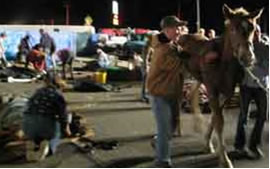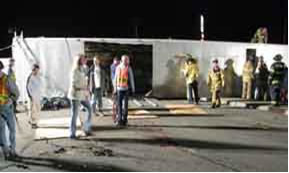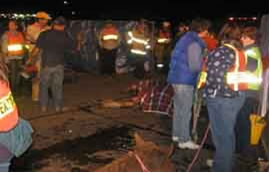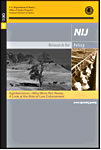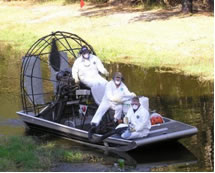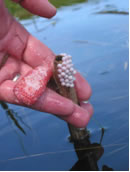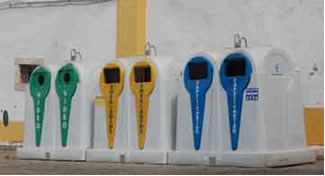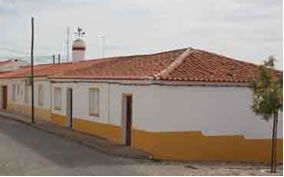
Vol. 3, No. 12, December 2007 |
 Printer-Friendly PDF Version Printer-Friendly PDF Version |
EDEN Conference ?Clemson, SC ?January 8-10
 The Madren Conference Center in Clemson, South Carolina.
The Madren Conference Center in Clemson, South Carolina.Conference is scheduled for the Madren
Conference Center, Clemson, South
Carolina from January 8-10, 2008. This is
the third of six EDEN regional conferences
focusing on animal agrosecurity issues.
Conference objectives are:
understand their role and
responsibilities in the event of
animal agrosecurity incidents (i.e.,
Agencies and other emergency management groups will have an improved
understanding of Extension's educational and facilitation role, and the resources
available through the Extension Disaster Education Network (EDEN). The conference
agenda includes time for Extension and agency representatives to discuss state and
multi-state approaches to agrosecurity incidents.
According to Carol of the University of Florida, it is time to "get the word out?to
|
individuals who have a vested interest in emergency management and could benefit from attending. States are encouraged to send teams to the conference, and carry the information back to co-workers. Teams should consider including representatives from Cooperative Extension |
responsibilities), the State Veterinarian, Animal Health Bureau, Department of
Agriculture, Emergency Management Agency, Health Department; SART; Law
Enforcement; and commodity groups representing integrated dairy, livestock and
poultry production.
A conference flyer is available at:
http://www.eden.lsu.edu/LearningOps/Workshops/AnimalAgroSecurity2007/Southe
ast/SE-RACC-PageOverview.pdf.
Information on logistics, agenda and registration is available at:
http://www.eden.lsu.edu/LearningOps/Workshops/AnimalAgroSecurity2007/Southe
ast/default.aspx.
Direct questions to me (clehtola@ufl.edu) or to Howard van Dijk (hdijk@clemson.edu),
who is the conference host.
[top]
Next Quarterly SART Advisory Board Meeting
Is Timed With Training Event
 A 48-hour live training event will be held at the Marion County 4-H Farm prior to the March 2880 Advisory Board Meeting.
A 48-hour live training event will be held at the Marion County 4-H Farm prior to the March 2880 Advisory Board Meeting.The next Quarterly SART Advisory Board Meeting is scheduled for 10 AM Wednesday, March 5, 2008 at the 41-acre Marion County 4-H Farm, 2232 NE Jacksonville Rd., Ocala, FL 34470 (352) 671-8400. Please note this change of venue!
The meeting will begin following a 48-hour live training event held as a "planned, response to a local disaster," possibly an event involving a mock chemical release. The training event is designed to test equipment, coordination and procedures across several of the SART disaster response partners. SART members John Haven (havenj@mail.vetmed.ufl.edu), Director of the College of Veterinary Medicine, University of Florida, and David Perry (perryda@doacs.state.fl.us), DOACS ACP Administrator can be contacted for additional information about the event.
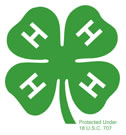 A 48-hour live training event will be held at the Marion County 4-H Farm prior to the March 2880 Advisory Board Meeting.
A 48-hour live training event will be held at the Marion County 4-H Farm prior to the March 2880 Advisory Board Meeting.The Quarterly Advisory Board Meeting will highlight significant opportunities to become more involved in SART efforts and is truly a "must-attend" for all agencies and organizations that participate in disaster planning and response. The meeting will include time to tour and examine the significant resources of the SART partners participating in the training event. In addition to the regular business of monitoring Florida's readiness for a disaster, discussion will include a NASAAEP update on the National Alliance of State Animal and Agricultural Emergency Programs (http://www.tnavc.org/mynavc/Default.aspx?tabid=257) which will have held its formative meeting at the Gaylord Hotel during the North American Veterinary Conference in Orlando January 22-23, 2008. [Directions to the Marion County 4-H Farm: From Interstate 75, take exit #354 and turn east on US Hwy. 27. Proceed about 3 miles to US Hwy 441/301 and turn left/north. It is less than a mile to NE 20th St. (Old Jacksonville Road); turn right/east. It is approximately a mile to the facility.]
Dramatic Equine Rescue in Illinois
|
A traffic accident near Chicago in late October tested that state's emergency animal responders. Apparently, 59 draft horses were being transported inside a double- decker semi-trailer. The truck driver ran a traffic light and collided with a pick-up truck. As a result, as many as 18 of the horses were ultimately euthanized.
has links to additional information and photos of the Illinois accident. [Photos courtesy www.BristolWisconsin.com.] |
[top]
Pet First Aid & Disaster Response Guide
Pets America has just released its "Pet First Aid & Disaster Response Guide,?an
excellent and colorful 118-page 5 ½" x 8 ½" illustrated handbook that every pet
owner should own, read and periodically review.
|
"Pet First Aid & Disaster Response Guide?is designed in two parts. Elaine Acker, founder of Pets America, authored Part One, which is titled "Critical Lessons from Veterinarians.?In this section, Acker reviews steps that pet owners may take to prepare for and then respond to a pet emergency. One of the many contributions that make this small handbook so useful is the inclusion of Normal Vital Sign information to help pet owners judge when their pet may be experiencing stress. She also gives valuable First Aid information so that pet owners can respond quickly to various pet emergencies (bites, burns, poisons, etc.), before a veterinarian can be located. David Chapman's illustrations truly bring this section alive. |
Wang (with Rick Sapp), this section concerns making a disaster action plan for pets
and people. It begins with a brief discussion of emergencies and dealing with those
adrenaline-inducing disruptions to our routines; then, it speaks to the heart of a
personal commitment to Being Prepared ?having a blueprint in-place for that f
unexpected moment when something suddenly happens, when it would be easy for
anyone without a plan to panic and to forget vital details and information.
Dedicating the book, Elaine Acker quotes her mother, Katherine: "It's the things you
know to do but don't do that get you into trouble.?Indeed.
The Pets America "Pet First Aid & Disaster Response Guide?is published by Pets
America, P.O. Box 40997, Austin, TX 78704 (512) 497-7535. It can be ordered for
$14.95 from Texas A&M Press through www.PetsAmerica.org. A network of SART-type, state veterinary medical reserve corps and state programs ?
the National Alliance of State Animal and Agricultural Emergency Programs or
NASAAEP ?are holding a formative meeting during the North American Veterinary
Conference in Orlando January 22-23, 2008.
|
The Veterinary Conference will include a NASAAEP organizational working group meeting on the afternoon of January 22, an evening reception that same evening and a day of presentations and updates on January 23rd. If you are registered for the Veterinary Conference, you can attend this meeting for no additional fee. If you would like to attend only this session, you can register for $85, which includes lunch, at http://www.tnavc.org/mynavc/Default.aspx?tabid=257. |
Presentations will include:
NASAAEP sessions will be open to all vet conference attendees. The new group is
appropriate for all SART/VMRC (and similar programs) leaders and participants, local program
(such as CART) leadership, national organization personnel and federal personnel.
[top]
Florida Counties Designated "Drought Disaster Areas?
Allows Farmers-Ranchers to Apply for Assistance
because of drought losses continuing since January 1, 2007. In addition, the nine
counties adjacent to drought-affected counties (Broward, Charlotte, Highlands, Lee,
Mimi-Dade, Monroe, Okeechobee, Palm Beach and Pinellas) also qualify for natural
disaster benefits because their counties are contiguous.
|
Qualified Florida farm operators may be eligible for low interest emergency drought disaster loans from USDA's Farm Service Agency (FSA). Farmers have eight months to apply for such loans to help cover actual losses. Interested individuals may contact USDA FSA Service Centers for information on eligibility and application procedures. Additional information is also available online at http://disaster.fsa.usda.gov. |
|
|
"I received this link ?www.ojp.usdoj.gov/nij/pubs-sum/214752.htm - via NCJRS International Monthly Accessions List and wanted to forward it should anyone be interested in light?reading,?wrote Corporal Julio Schrodel who is in Planning &
because of its continuing outbreaks in England), is summarized below. The full text is available at that site as a PDF document: Agroterrorism—Why We're Not Ready: A Look at the Role of Law Enforcement An agroterrorism attack would dramatically impact many aspects of American life, including law enforcement, which ?especially in rural areas ?is financially and strategically unprepared to respond. This Research for Policy considers the effect of the introduction of foot-and-mouth disease to the American cattle industry, including the mandatory slaughter of millions of animals and an impact of up to $60 billion on the U.S. economy. The publication outlines why law enforcement is not currently ready for such a terrorist attack and offers guidance for preventing and preparing to respond to an act of agroterrorism. [top] [top] Eligible dairy producers can sign up for the Dairy Disaster Assistance Program (DDAP- III) at local USDA Farm Service Agency (FSA) service centers beginning Monday, December 3rd.
to market. To be eligible, producers must have suffered losses in primary and contiguous counties declared or designated a natural disaster. Also, producers in counties receiving an FSA Administrator's Physical Loss Notice determination are eligible. USDA provides more information on proposed DDAP-III provisions in a fact sheet posted online at: http://disaster.fsa.usda.gov. [top] Paul Gibbs, Veterinarian and Professor of Virology in the University of Florida's College of Veterinary Medicine, has developed a training module titled "Recognizing and Responding to Foreign Animal Diseases.?This module, part of the Keep Florida Safe series may be viewed directly at www.flsart.org/training/index.html or by clicking on the "Training Materials" menu at http://www.flsart.org and selecting this module. This module has been developed in a particularly interesting format with voice-overs and viewer interactive abilities. These features help viewers retain information about the module's four principal points: 1. The dangers of foreign animal diseases,
[top] Gary Warren of the Florida Fish and Wildlife Conservation Commission (FWCC) recently identified Island Apple Snails in Newnan's Lake east of Gainesville. Newnan's is the largest lake in Alachua County. This exotic species was first identified in Florida lakes in 1987, but this is the first discovery of exotic snails in Alachua County. Although the Florida Apple Snail is a native species, its four exotic cousins are now loose in the state: the Channeled, Florida, Island, Spike-topped (also called Golden) and Titan. Florida's snail is the smallest of the five and the only one that lays white eggs. The others are native to South America and lay eggs that are pink or green (Titan). The Island Apple Snail is twice as large as its Florida relative, breeds profusely and lives up to four years. While these snails could strip a lake of all aquatic vegetation (they have caused significant damage in Asia and the Pacific), according to the FWCC, no damage attributable solely to the Island Apple Snail has yet been documented. So, there is both bad news and good news. o FWCC officers say the recent introductions in Newnan's Lake were most likely caused when aquarium owners dumped unwanted contents. o FWCC researchers suspect that someone in the exotic pet trade placed snails in Lake Okeechobee canals to breed and sell them. o Exotic Apple Snails are found from Tallahassee to Miami. citizen. o Bill Haller, University of Florida Director of the Center for Aquatic and Invasive Plants, says that covering Apple Snail eggs with canola oil or simply scraping them into the water prevents them from hatching.
The FWCC and the St. Johns River Water Management District treated the suspect area (the boat ramp) of Newnan's Lake with copper sulfate and more than two-dozen dead snails have been found. The WMD continues to inspect the site to remove egg clutches. For additional information, please visit www.floridadep.org/central/Home/Watershed/snails/Snails.htm and http://myfwc.com/nonnatives/Docs/FWC_applesnails_FLMS_handout.pdf. [top]
On a recent trip, your Editor noticed these unusual recycling bins in Portugal: blue = Papel/Cartão (paper/cardboard), gold = Embalagens (plastic packages) and green = Vidro (glass). Color schemes of recycling containers matched the houses, most of
[top] Editor: Rick Sapp, PhD, Technical Writer, Florida Department of Agriculture & Consumer Services, Division of Animal Industry [rsa5@cox.net] Associate Editor: Joe Kight, State ESF-17 Coordinator, Florida Department of Agriculture & Consumer Services, Division of Animal Industry [kightj@doacs.state.fl.us] The SART SENTINEL is an E-mail newsletter prepared monthly by Rick Sapp and the members of the Florida State Agricultural Response Team. Past issues of the Sentinel are archived on the Florida SART Web Site, www.flsart.org. If you have a story or photo that you would like to have considered for publication in The SART SENTINEL, please contact the Editors. [top] |
||||||||||||||||||||||



